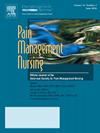The Effect of Topical Capsaicin 8% on Pain in Chemotherapy-induced Peripheral Neuropathy
IF 1.6
4区 医学
Q2 NURSING
引用次数: 0
Abstract
Background
Chemotherapy-induced peripheral neuropathy (CIPN) can cause chemotherapy dose reductions and impact patients’ quality of life. Few proven treatments exist, with generally modest analgesic effects and possible side effects. Small studies show the beneficial effects of topical capsaicin 8% on pain.
Aim
To investigate capsaicin's effects on pain, neurotoxicity, and mood in patients with CIPN.
Design
Prospective data collection in patients treated with capsaicin 8% for painful CIPN.
Methods
In 17 patients, data was collected before (t0) and directly (t1), 2 weeks (t2), and 8 weeks (t3) after capsaicin 8% treatment. Differences between t0-t2 and t0-3 were assessed for pain (Numeric Rating Scale [NRS]; acceptability), neurotoxicity symptoms (20-item questionnaire [CIPN20]; mechanical detection [MDT] and pain [MPT] thresholds), and mood (Hospital Anxiety and Depression Score [HADS]).
Results
For 9 patients (53%), pain became “acceptable” at t2 and t3, with a significant reduction (pain intensity difference [PID]t0-2: –1.72, PIDt0-3: –2.47, both p < .001), whereas average NRS did not change significantly for patients scoring “unacceptable.” HADS anxiety scores remained unchanged, whereas depression scores decreased from baseline (t0-2: –1.47, p = .014; t0-3: –1.36, p = .021). CIPN20 decreased from baseline (t0-2: –1.87, p = .004; t0-3: –3.32 p = .002). MPT was significantly lower post-treatment and MDT did not change.
Conclusions
Capsaicin 8% can have a beneficial analgesic effect in patients with CIPN-related pain but with a marked “on-off” effect. Mood changes were marginal. Quantitative sensory testing findings do not support earlier findings on nerve degeneration after capsaicin treatment, although the study size was small for definitive conclusions.
外用8%辣椒素对化疗引起的周围神经病变疼痛的影响。
背景:化疗诱导的周围神经病变(CIPN)可导致化疗剂量减少,影响患者的生活质量。很少有经证实的治疗方法存在,通常具有适度的镇痛作用和可能的副作用。小型研究表明,局部使用辣椒素对疼痛的有益效果为8%。目的:探讨辣椒素对CIPN患者疼痛、神经毒性和情绪的影响。设计:采用8%辣椒素治疗疼痛性CIPN患者的前瞻性数据收集。方法:17例患者,分别于辣椒素8%治疗前(t0)、直接(t1)、2周(t2)、8周(t3)采集数据。评估t0-t2和t0-3之间的疼痛差异(数值评定量表[NRS];可接受性)、神经毒性症状(20项问卷[CIPN20];机械检测[MDT]和疼痛[MPT]阈值)和情绪(医院焦虑和抑郁评分[HADS])。结果:9例患者(53%)在t2和t3时疼痛变为“可接受”,显著降低(疼痛强度差[PID] 0-2: -1.72, pid0 -3: -2.47,均p < .001),而评分为“不可接受”的患者的平均NRS无显著变化。HADS焦虑评分保持不变,而抑郁评分从基线开始下降(10 -2:-1.47,p = 0.014;T0-3: -1.36, p = 0.021)。CIPN20较基线下降(0-2:-1.87,p = 0.004;T0-3: -3.32 p = .002)。治疗后MPT显著降低,MDT无变化。结论:8%辣椒素对cipn相关疼痛患者具有有益的镇痛作用,但具有明显的“开-关”效应。情绪变化微乎其微。定量感觉测试结果不支持辣椒素治疗后神经变性的早期发现,尽管研究规模很小,无法得出明确的结论。
本文章由计算机程序翻译,如有差异,请以英文原文为准。
求助全文
约1分钟内获得全文
求助全文
来源期刊

Pain Management Nursing
医学-护理
CiteScore
3.00
自引率
5.90%
发文量
187
审稿时长
>12 weeks
期刊介绍:
This peer-reviewed journal offers a unique focus on the realm of pain management as it applies to nursing. Original and review articles from experts in the field offer key insights in the areas of clinical practice, advocacy, education, administration, and research. Additional features include practice guidelines and pharmacology updates.
 求助内容:
求助内容: 应助结果提醒方式:
应助结果提醒方式:


